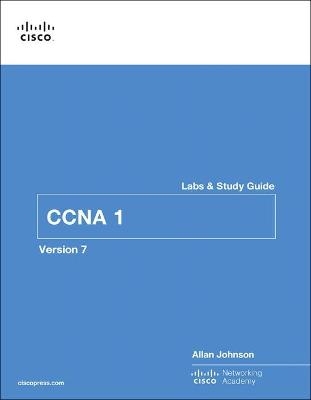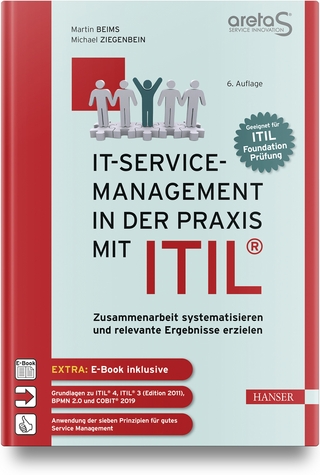
Introduction to Networks Labs and Study Guide (CCNAv7)
Cisco Press (Verlag)
978-0-13-663445-4 (ISBN)
Vocabulary Matching Exercises
Concept Questions Exercises
Skill-Building Activities and Scenarios
Configuration Scenarios
Packet Tracer Exercises
Troubleshooting Scenarios
The Labs & Activities include all the online course Labs and Packet Tracer activity instructions. If applicable, this section begins with a Command Reference that you will complete to highlight all the commands introduced in the chapter. This book is offered exclusively for students enrolled in Cisco Networking Academy courses. It is not designed for independent study or professional certification preparation. Visit netacad.com to learn more about program options and requirements. Related titles: CCNA 200-301 Portable Command Guide Book: 9780135937822 eBook: 9780135937709 Introduction to Networks Companion Guide CCNAv7 Book: 9780136633662 eBook: 9780136633549 Introduction to Networks Course Booklet CCNAv7 Book: 9780136632955
Allan Johnson entered the academic world in 1999 after 10 years as a business owner/operator to dedicate his efforts to his passion for teaching. He holds both an MBA and an M.Ed in occupational training and development. He taught a variety of technology courses to high school students and is an adjunct instructor at Del Mar College. Since 2006, Allan has worked full time for Cisco Networking Academy in several roles. He is currently engaged as Curriculum Lead. Cisco Networking Academy isan innovative Cisco education initiative that delivers information andcommunication technology skills to improve career and economic opportunitiesaround the world. The Academy provides online courses, interactive tools, andlab activities to prepare individuals for information technology and networkingcareers in virtually every industry.
Introduction xxx
Chapter 1 Networking Today 1
Networks Affect Our Lives 2
Network Components 2
Network Representations and Topologies 4
Common Types of Networks 5
Internet Connections 6
Reliable Networks 8
Network Trends 9
Network Security 11
The IT Professional 12
1.5.7 Packet Tracer—Network Representation 13
1.9.3 Lab—Research IT and Networking Job Opportunities 16
Chapter 2 Basic Switch and End Device Configuration 19
Cisco IOS Access 20
IOS Navigation 21
The Command Structure 23
Basic Device Configuration 25
Save Configurations 27
Ports and Addresses 27
Configure IP Addressing 28
Verify Connectivity 30
Command Reference 32
2.3.7 Packet Tracer—Navigate the IOS 33
2.3.8 Lab—Navigate the IOS by Using Tera Term for Console Connectivity 38
2.5.5 Packet Tracer—Configure Initial Switch Settings 45
2.7.6 Packet Tracer—Implement Basic Connectivity 50
2.9.1 Packet Tracer—Basic Switch and End Device Configuration 53
2.9.2 Lab—Basic Switch and End Device Configuration 55
Chapter 3 Protocols and Models 59
The Rules 60
Protocols 61
Protocol Suites 63
Standards Organizations 66
Reference Models 68
Data Encapsulation 69
Data Access 71
3.0.3 Class Activity—Design a Communications System 73
3.4.4 Lab—Research Networking Standards 74
3.5.5 Packet Tracer—Investigate the TCP/IP and OSI Models in Action 77
3.7.9 Lab—Install Wireshark 82
3.7.10 Lab—Use Wireshark to View Network Traffic 84
Chapter 4 Physical Layer 91
Purpose of the Physical Layer 92
Physical Layer Characteristics 92
Copper Cabling 94
UTP Cabling 96
Fiber-Optic Cabling 97
Wireless Media 99
4.6.5 Packet Tracer—Connect a Wired and Wireless LAN 101
4.6.6 Lab—View Wired and Wireless NIC Information 105
4.7.1 Packet Tracer—Connect the Physical Layer 109
Chapter 5 Number Systems 115
Binary Number System 116
Hexadecimal Number System 118
Chapter 6 Data Link Layer 123
Purpose of the Data Link Layer 124
Topologies 126
Data Link Frame 128
Chapter 7 Ethernet Switching 131
Ethernet Frames 132
Ethernet MAC Address 134
The MAC Address Table 135
Switch Speeds and Forwarding Methods 140
7.1.6 Lab—Use Wireshark to Examine Ethernet Frames 142
7.2.7 Lab—View Network Device MAC Addresses 149
7.3.7 Lab—View the Switch MAC Address Table 155
Chapter 8 Network Layer 159
Network Layer Characteristics 160
IPv4 Packet 161
IPv6 Packet 163
How a Host Routes 164
Introduction to Routing 166
Chapter 9 Address Resolution 171
MAC and IP 172
ARP 173
IPv6 Neighbor Discovery 175
9.1.3 Packet Tracer—Identify MAC and IP Addresses 177
9.2.9 Packet Tracer—Examine the ARP Table 181
9.3.4 Packet Tracer—IPv6 Neighbor Discovery 185
Chapter 10 Basic Router Configuration 191
Configure Initial Router Settings 192
Configure Interfaces 194
Configure the Default Gateway 196
Command Reference 197
10.1.4 Packet Tracer—Configure Initial Router Settings 198
10.3.4 Packet Tracer—Connect a Router to a LAN 202
10.3.5 Packet Tracer—Troubleshoot Default Gateway Issues 207
10.4.3 Packet Tracer—Basic Device Configuration 210
10.4.4 Lab—Build a Switch and Router Network 212
Chapter 11 IPv4 Addressing 219
IPv4 Address Structure 220
IPv4 Unicast, Broadcast, and Multicast 224
Types of IPv4 Addresses 224
Network Segmentation 226
Subnet an IPv4 Network 227
VLSM Addressing Schemes 231
11.5.5 Packet Tracer—Subnet an IPv4 Network 236
11.6.6 Lab—Calculate IPv4 Subnets 241
11.7.5 Packet Tracer—Subnetting Scenario 245
11.9.3 Packet Tracer—VLSM Design and Implementation Practice 249
11.10.1 Packet Tracer—Design and Implement a VLSM Addressing Scheme 253
11.10.2 Lab—Design and Implement a VLSM Addressing Scheme 255
Chapter 12 IPv6 Addressing 261
IPv4 Issues 262
IPv6 Address Representation 263
IPv6 Address Types 263
GUA and LLA Static Configuration 265
Dynamic Addressing for IPv6 GUAs 267
Dynamic Addressing for IPv6 LLAs 272
IPv6 Multicast Addresses 272
Subnet an IPv6 Network 272
12.6.6 Packet Tracer—Configure IPv6 Addressing 276
12.7.4 Lab—Identify IPv6 Addresses 280
12.9.1 Packet Tracer—Implement a Subnetted IPv6 Addressing Scheme 284
12.9.2 Lab—Configure IPv6 Addresses on Network Devices 286
Chapter 13 ICMP 291
ICMP Messages 292
Ping and Traceroute Tests 296
Command Reference 297
13.2.6 Packet Tracer—Verify IPv4 and IPv6 Addressing 297
13.2.7 Packet Tracer—Use Ping and Traceroute to Test Network Connectivity 301
13.3.1 Packet Tracer—Use ICMP to Test and Correct Network Connectivity 305
13.3.2 Lab—Use Ping and Traceroute to Test Network Connectivity 307
Chapter 14 Transport Layer 319
Transportation of Data 320
TCP Overview 322
UDP Overview 325
Port Numbers 327
TCP Communication Process 329
Reliability and Flow Control 332
UDP Communication 334
Command Reference 336
14.8.1 Packet Tracer—TCP and UDP Communications 336
Chapter 15 Application Layer 343
Application, Presentation, and Session 344
Application Layer 344
Peer-to-Peer 346
Web and Email Protocols 347
IP Addressing Services 349
File Sharing Services 353
Command Reference 355
15.4.8 Lab—Observe DNS Resolution 355
Chapter 16 Network Security Fundamentals 359
Security Threats and Vulnerabilities 360
Network Attacks 361
Network Attack Mitigation 364
Device Security 366
Command Reference 368
16.2.6 Lab—Research Network Security Threats 368
16.4.6 Packet Tracer—Configure Secure Passwords and SSH 372
16.4.7 Lab—Configure Network Devices with SSH 375
16.5.1 Packet Tracer—Secure Network Devices 381
16.5.1 Lab—Secure Network Devices 383
Chapter 17 Build a Small Network 389
Devices in a Small Network 390
Small Network Applications and Protocols 392
Scale to Larger Networks 394
Verify Connectivity 395
Host and IOS Commands 397
Troubleshooting Methodologies 402
Troubleshooting Scenarios 403
Command Reference 405
17.4.6 Lab—Test Network Latency with Ping and Traceroute 406
17.5.9 Packet Tracer—Interpret show Command Output 411
17.7.6 Lab—Troubleshoot Connectivity Issues 413
17.7.7 Packet Tracer—Troubleshoot Connectivity Issues 418
17.8.1 Lab—Design and Build a Small Network 422
17.8.2 Packet Tracer—Skills Integration Challenge 423
17.8.3 Packet Tracer—Troubleshooting Challenge 426
| Erscheinungsdatum | 31.12.2019 |
|---|---|
| Reihe/Serie | Lab Companion |
| Verlagsort | Indianapolis |
| Sprache | englisch |
| Maße | 215 x 275 mm |
| Gewicht | 1044 g |
| Themenwelt | Schulbuch / Wörterbuch |
| Informatik ► Weitere Themen ► Zertifizierung | |
| Wirtschaft ► Betriebswirtschaft / Management | |
| ISBN-10 | 0-13-663445-1 / 0136634451 |
| ISBN-13 | 978-0-13-663445-4 / 9780136634454 |
| Zustand | Neuware |
| Haben Sie eine Frage zum Produkt? |
aus dem Bereich


